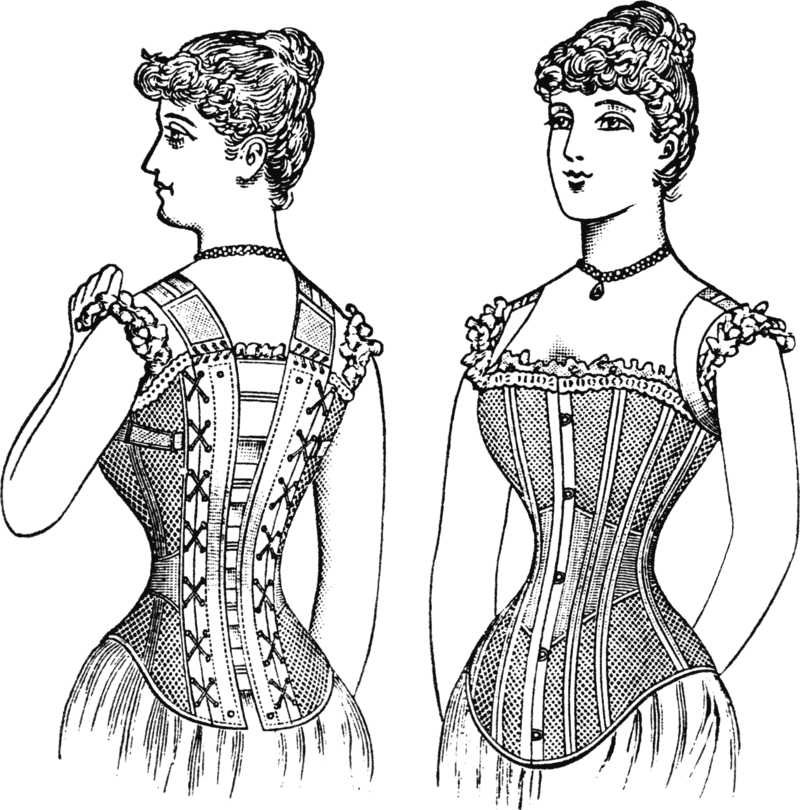Were Victorian corsets actually painful?
As someone who has a love for fashions of years gone by, I find myself often presented with the phrase ‘oh no I’d hate to wear that, imagine the pain from the corset!’. There is a belief amongst many that corsetry is a device of torture and that wearing one is excruciatingly painful. So, let’s take the question of whether corsets are actually painful, break it down and find the truth.
1890s corset sketch
Our immediate thought of a corset is the 19th-century Victorian one, but these kinds of corsets were popular for less than a century, and before them, there were stays and pairs of bodies. These too were worn underneath the main articles of clothing to produce the desired silhouette and support the bust and back, as well as the weight of the outer garments. Since the 16th century, wearing a supportive form of undergarment in the western world has been seen as the norm, if anything it is expected much like today we are expected to wear bras, right? I say all of this because we need to stop demonising the corset and begin to view it as what it was, a necessary item of supportive underwear.
‘But, surely it can’t have been safe to create such a small waist using corsets?’
The simple answer here is, the corsets alone didn’t create a small waist effect. And I use the word effect because it was basically an illusion. A correctly fitted and worn corset should fit snuggly against the body, much like the band of a bra, but not alter the shape of the wearer’s actual body. To create the illusion of a smaller waist throughout history, bum pads have been worn underneath other layers of clothing. I mean, it's pretty obvious when you look at certain time periods like the 1870s to see that their buttocks weren’t naturally that shape! Huge sleeves were also very popular in the 1830s and these also had the effect of making the waist look far smaller than it actually was. You know how in 2020 we go onto Instagram and we see photos of people and think ‘hah that’s not their real waist size, it’s clearly edited’, that was exactly same in the 19th century. They had their forms of photoshop! Many images touted online as showing so-called ‘extremely dangerous’ corsetry are manipulated. Being self-conscious of one’s body is sadly as old as time. And this should be obvious, but there is zero evidence to support the notion that women were removing ribs to make their waists smaller. With the state of medicine in the 19th century and earlier I don’t think that would exactly be a safe procedure!
‘But, what about tightlacing? Surely that was bad?’. Yes, it was. Forcing your body into an unnatural shape for prolonged periods of time is going to be dangerous and that goes without saying. However, tightlacing as a practice in the 19th century was rare and completely frowned upon. Much like today, there were people who were willing to go to extreme lengths to achieve their ideal of beauty, and sadly this could cause health issues as it can today. It was a very small minority of generally the social elite who would tight lace, the average Jane Smith did not.
‘Surely it would have hurt the skin at least?’. If worn correctly on top of a shift or chemise, nope! If you want to learn more about the wearings of shifts and chemises you can read about it here:
‘Ok, so why don’t we still wear them today then?’. Well, we kind of do. The modern bra is an evolution of the corset, a way to support the breasts and create the desired silhouette. Many also choose to wear shapewear like Spanx, and these too have evolved from the corset. Why they went out of fashion, however, is more complex to answer as there are several reasons. During the First World War, many more women found themselves working the jobs that men had done before then, giving women a new sense of liberation and freedom and due to this more relaxed silhouettes came into fashion. During the 1910s the corset became longer, creating a slender silhouette that did not focus on creating curves to accommodate for popular fashions. This then became the girdle. Oh, and I think I have to mention the patriarchy. With medical knowledge not being what it is today, many men chose to blame the corset for a myriad of conditions that plagued some women. Got hysteria? Ah, that’s because of your corset! Bad asthma? Corset! Leg pains? Corset!!
So, the answer to the question ‘Were Victorian corsets actually painful’ is no, they weren’t if they were fitted and worn correctly, and in the vast majority of cases, they were!
